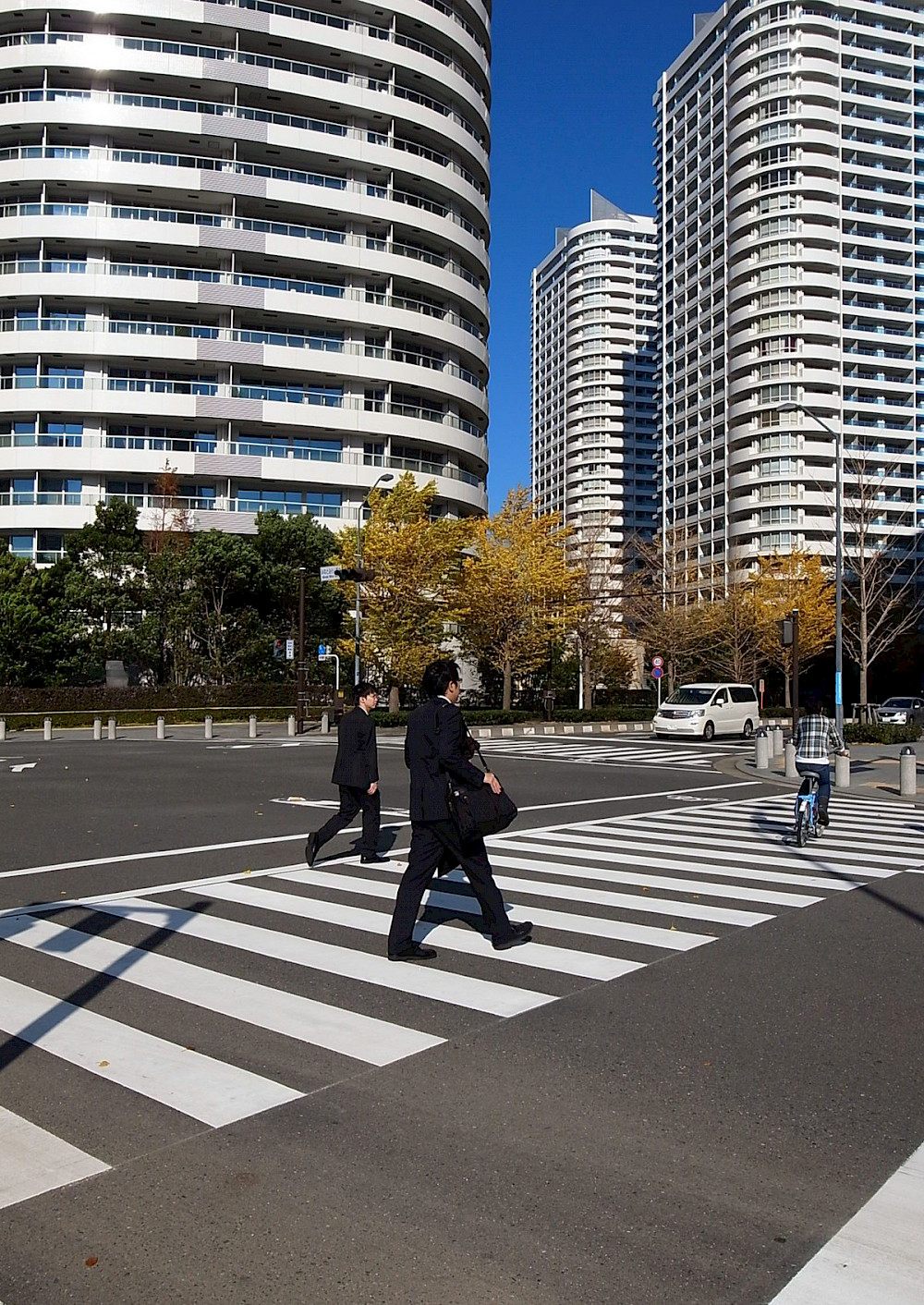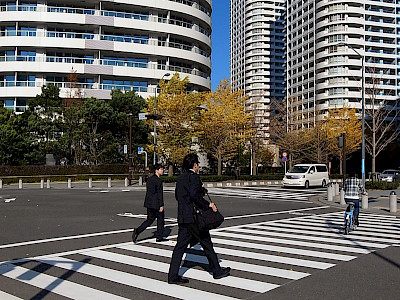10 — 12.05.2011
Toshiki Okada / chelfitsch Tokyo / Yokahama
We Are the Undamaged Others
theatre
Japanese → FR, NL | ⧖ 1h50
Unlike his earlier works, here Toshiki Okada concentrates on a generation of people in their thirties who have found their way through the hyper-regulation of Japanese society. The play is set just before major national elections. Between action and narration and live and indirect speech, the actors present a couple to us around which real or fantasised characters gravitate. Well set-up in life, they have all the attributes of happiness: or so it appears. However, the almost choreographed conversations, like the attitudes, and above all the distance between these words and these bodies, translate a profound confusion. Against a backdrop of class differences, We Are the Undamaged Others challenges the meaning of happiness. Close to The Sonic Life of a Giant Tortoise in its intentions, this work is distinguished by its elliptical form and weightlessness – it is more Antonioni who comes to mind here. With the inimitable language which has made him one of the greatest directors around today, Okada offers us a show featuring the doubts and illusions of a generation torn between its dreams of freedom and its fear of losing what it has acquired.
General questions (2008)
How do you approach the writing of a new work and at what point do you introduce stage work – in particular with the actors and dancers from chelfitsch?
When I write a text, I don’t think about the stage work. I only start to take it into consideration when I go into the rehearsal room. I don’t have any preconceived ideas about the way actors should use their bodies before they actually start trying to move them during rehearsals: as rehearsals go on, I get ideas about the actors’ movement. So generally the writing process is distinct from the staging. But at the same time, when I write a text I try to do it in a way that can influence the actors’ bodies in one way or another.
Your writing and your theatre seem to work quite a bit on the notion of “suspended time” and “present time”.
That’s right. I think that one of theatre’s key roles is to allow the audience to experience a different time from the one experienced in their day-to-day lives. My interest in the notion of time is linked quite a bit to the stretching of time which is at work on stage. Making it the subject matter of what I write is not enough, I need to produce it on stage.
What was your aim when you set up chelfitsch? Your shows are often on the dividing line between theatre and dance. What importance and what function do you give bodies and words?
Initially when I started using Japanese slang in my work, it was simply an idea. Later, I saw that it was a turning point. I had to find movements that could perfectly match this kind of language. I get lots of ideas about the body in this process. For example, I get bored if the actors’ bodies are limited to accompanying the words they are saying. An auxiliary body content with “tracing” the trajectory of the words seemed to me to “impoverish” the expression. So I asked the actors to separate their bodies from what they were saying and generate movements starting from what I call “images” or “feelings”, something which generally precedes words when we speak. And what you see is a solution: a solution that is only temporary. I’m always working with the actors and developing their movements further. In my plays, I consider the actors’ movements to be a kind of “naturalism”, not in the traditional sense of the word but as an extension of it. If I make the actors “dance”, it’s not deliberate. It’s not my intention. All that I’m aware of doing is trying to extend the actors’ bodies. One of the important things I ask actors to do is to move consciously on stage as if they were in the process of improvising, even if in reality they’ve worked on and memorised the movements a thousand times. That’s all there is to say about the importance I attach to bodies. As for the words, I definitely pay attention to their meaning but more than that, I’d like to emphasise here the fact that speech acts on the speaker’s body. Once again, I always have this power in mind when I write the words for a play. Speech can unleash unexpected movements.
You said that using slang marked a turning point for you. In what way and how do you seek to make this dimension of your writing accessible to a non-Japanese audience?
My plays are actually written in the Japanese slang we speak nowadays in and around Tokyo. Some people – generally from the older generations – criticise young Japanese people for the “poverty” of this language. As a form of rebellion against this, my intention has therefore been to create a “rich” play based on what they stigmatise as “poor” language and show them the complexity and sincerity actually in action here. It’s a challenge to succeed in conveying everything happening to a non-Japanese audience. But I’m confident, all the more so since the experience of having played to different audiences who don’t understand Japanese has shown me that a relationship can still be established between them and my work, and that the movement alone of the actors is enough to make them feel the language being spoken on stage. Even people who don’t understand Japanese can see that the strength of the shows is not simply down to language, but also down to the relationship established between the language and the body. Every time we’ve been in a position to present the show correctly – that is to articulate the relationship between the language and the body (both its distance and proximity) through the show – the audience has turned out to be captivated by what we did. It’s fascinating to see the extent to which the audience reaction has always correlated closely with the success of what we do on stage. As far as I can judge, it is as if the language barrier doesn’t really exist.
Interview with Toshiki Okada (2010)
What was the starting point for We Are the Undamaged Others? How did you work on the words for this play?
We had a major event in Japan in August 2009 when the ruling political party was replaced for the first time in a very long time [Toshiki Okada is referring to the rather conservative Liberal Democratic Party (LDP) which had for a long time been Japan’s biggest political party and practically always governed the country until its defeat in the legislative elections in August 2009, Ed.]. This change was an important event in ourhistory because one single political party had been running the countryfor a long time. I had no idea of what kind of impact this could have, but I felt that it would be an enormous change. That was my starting point and what I wanted to write about: the fact of not knowing what it meant for us now. At the same time, I had another reason for writing this play. The belief that “120 million Japanese people all belong to the middle class” has to a greater or lesser extent impregnated our minds for many years. Japanese society was supposed to be classless. In truth, these differences did exist; it’s just that they were more or less invisible and undetectable. Times have changed and today this discrimination is becoming a lot more noticeable, as in Europe. This fact and the confusion I feel about it is something else I wanted to express through this play/choreography.
You’ve said that you wanted to work on the notion of “variation” in this play, drawing inspiration from the artist Robert Rauschenberg. How?
Although some people consider my work to be “cubist”, what I’ve tried to do in this play was get closer to Robert Rauschenberg’s work using various materials. I haven’t been directly influenced by Rauschenberg and I only saw this connection after writing the play. Whatever the case may be, the result of my experiments on the idea of “variation” could – or not – be described as a “collage” transposed to theatre. Of course I’m still far from achieving Rauschenberg’s level of sophistication. In any case, that’s my conception of “variation”.
You’ve also said that you want to explore abstraction more. How?
When I was writing the play, I thought about ways of representing something in a “realistic” way. For example, take someone who is sitting on a chair on stage without acting. If I say to the audience that this person is very sad, then he’s going to seem sad. Starting from the power of speech, I began thinking about what is known as “realistic representation” and its possible meanings in theatre. What could the actor, or more precisely his body, do on the chair? Those are the kind of questions I had in mind when writing the play and rehearsing it with the actors. Even if the objects and actors on stage make no effort towards giving a “realistic” representation, in some circumstances they still can’t help representing what the words say, resembling the way the words describe them. This play talks about that: about the power of quasi irresistible representation of the medium of language. And by reflecting on the signifying processes of the body and of language, my words ended up becoming abstract. Not that the content in itself is abstract: simply that, even if it can seem a little paradoxical, the method of “realistic” representation took it to a high degree of abstraction.
Interviews by David Sanson for the Festival d’Automne à Paris 2010, conducted between 2008 and April 2010
Translation: Claire Tarring
Text & direction
Toshiki Okada
Performers
Taichi Yamagata, Shoko Matsumura, Riki Takeda, Mari Ando, Izumu Aoyagi, Yukiko Sasaki, Makoto Yazawa
Stage manager
Koro Suzuki
Music
Yoshio Otani
Set design
TORAFU ARCHITECTS (Koichi Suzuno, Shinya Kamuro)
Light
Tomomi Ohira
Sound
Norimasa Ushikawa
Translation
Mathieu Capel & Hirotoshi Ogashiwa
Producer
Akane Nakamura
Production manager
Tamiko Ouki
Presentation
Kunstenfestivaldesarts, Théâtre National de la Communauté française
Production
chelfitsch (Tokyo)
Associate production
precog (Tokyo)
Coproduction
Aichi Triennale (Nagoya), Festival d’Automne à Paris, Théâtre de Gennevilliers, Centre Dramatique National de Création Contemporaine (Paris), Noorderzon Performing Arts Festival (Groningen)
Supported by
Agency for Cultural Affairs, Government of Japan in the fiscal 2011, The Saison Foundation
Thanks to
Steep Slope Studio
Subtitling supported by
ONDA


